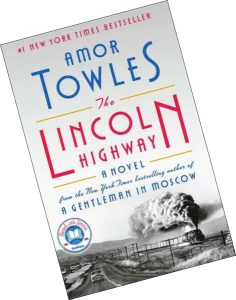On the reading highway
Where do I begin to tell the story of how engaging it was to read Amor Towles’s The Lincoln Highway, all 576 pages of it in smallish print? Possibly for the first time in over 60 years of reading, I fell in love with a chapter. Chapter 3, which appears in the middle of the second half of the book. Reading the book is rather like venturing out into space, the great unknown. Except that much is known. Let me explain. In a Q&A I chanced upon while browsing the internet, the author says, ‘After dwelling for days on the draft’s shortcomings to no avail, I suddenly realized that the book… was a countdown. So, I went back to the beginning and began revising — having renamed the sections as Ten, Nine, Eight, and so on. This helped clarify for me what belonged in the story and how it should be told. … But when I finished the first draft, it seemed to me that the reader deserved to have the same experience while reading the book that I had while writing it: of knowing that the story was not open-ended, but ticking down day by day to its inescapable conclusion.’
It starts off with 18-year-old Emmett Watson, newly released from a juvenile correctional facility of sorts, and his little brother Billy, setting off from their home in Nebraska in a powder blue Studebaker to find their mother in far-off San Francisco. They decide to take the Lincoln Highway upon Billy’s insistence. As precocious Billy clarifies, ‘It was invented in 1912 and was named for Abraham Lincoln and was the very first road to stretch from one end of America to the other.’ It goes from Times Square in New York, over 3,390 miles (5,456 km), all the way to Lincoln Park in San Francisco. He has a logical explanation for why he thinks they will find their mother, who had abandoned them years ago, in San Francisco on a particular day.
It must be mentioned here that their father has just died, leaving them nothing and so Emmett decides to make a new start. Unexpectedly, they are joined on the journey by two fellow inmates of the facility, Woolly who is woolly-headed as they come, and Duchess aka Daniel, who is sharper than a knife. They have their own agendas, and as Emmett tries his darndest to get on track, the journey metamorphoses into an engrossing tale of twists and turns, diverting, stirring, inevitable in turns. Billy carries with him a secret — or maybe, not so secret — weapon: Professor Abacus Abernathe’s Compendium of Heroes, Adventurers, and Other Intrepid Travelers. Armed with a plethora of hero stories from this compendium, Billy tags along with his brother and his two not-really-mates with faith and myths. How the road trip progresses, what happens along the way, the people they meet, the things they learn apart from getting acquainted with the likes of Macbeth, Ulysses, Hercules and others of that ilk, is what the book is about.
In Chapter 3, what happens is… no, let that remain under wraps so you can come to your own conclusion after experiencing glorious storytelling and style, and meeting some remarkable characters. You will be surprised how often you will identify with a person or a situation or an observation. Yet, the writing is light, it lifts and delights, it makes you float on the magic of words and ideas, and the flights of imagination it takes you on are kind of cool.
An earlier book by Towles, A Gentleman in Moscow, is highly critically acclaimed and has even been serialised on Netflix. I have neither read that book nor watched the serial. But The Lincoln Highway got me curious about the author. In a section called ‘The Books of My Life’ published in The Guardian (April 19, 2024), Towles talks about the books that influenced him. ‘Reading was always encouraged in my house,’ he says. ‘But when I was in my early teens, my father would occasionally offer me money to read a book he was convinced I would like but I was reluctant to pick up due to its length. The three books he paid me to read: JRR Tolkien’s The Lord of the Rings, James Clavell’s Shōgun and Gabriel García Márquez’s One Hundred Years of Solitude. I loved all three, but One Hundred Years of Solitude opened my eyes to a whole new tier of storytelling. It remains one of my three favourite books (along with Tolstoy’s War and Peace and Melville’s Moby-Dick).’
Ideas don’t just come, stories don’t take shape on their own. The writing process calls for preparation. Towles says in an article in the New York Times of September 23, 2021, ‘Before I set out on a new project, I like to read a handful of novels written in (and ideally set in) the time period in which I’m about to immerse myself. … The Lincoln Highway takes place over 10 days in June of 1954, so in anticipation I read a number of American works from the mid-50s including James Baldwin’s Go Tell It on the Mountain (1953); Raymond Chandler’s The Long Goodbye (1953); Flannery O’Connor’s A Good Man Is Hard to Find (1955); and Sloan Wilson’s The Man in the Gray Flannel Suit (1955).’
Then there is the business of how you tell the story, or rather whose story you tell. For instance, when a child comes home and describes something that happened, say, in school, it is her/his version, told from her/his point of view. Short stories, novels, any piece of writing… they all follow the same logic. ‘When I first outlined The Lincoln Highway,’ says Towles, ‘the plan was to describe the story from two alternating perspectives: Emmett’s (in the third person) and Duchess’s (in the first person). This seemed a natural way to juxtapose the two different personalities, upbringings, and moralities of the lead characters — and by extension, two different ways of being American. But once I was writing, the voices of the others characters began to assert themselves, making their own claim on the narrative, insisting that their points of view be heard.’ Heard they are, loud and clear.
I cannot recommend this book highly enough, it is unputdownable. And this is not said lightly. Further on in the article I’ve quoted from earlier, we realise that Towles didn’t know that the Lincoln Highway actually existed when he conceived of the story. But the moment he made this discovery, it ‘reinforced or reshaped a number of the book’s themes and events,’ he recalls. There is one photograph, on page 268 in the Penguin edition I read, ‘of Times Square with two police officers looking up the length of Broadway and not another living soul in sight.’ This came into the novel because Towles decided ‘to look at the front pages of the NYT for the ten days on which’ his story took place. He was amazed ‘by a story on June 14th announcing that all activity in New York City would stop for ten minutes on the following day as part of a nuclear attack simulation.’ The next day’s photograph showed an all but abandoned Times Square, showing the very spot the Lincoln Highway begins. That’s how we find Woolly reading old headlines in one chapter. Talk about art imitating life! Here, art and life come together.
The columnist is a children’s writer and senior journalist


